Planning a trip to Mexico, especially as an LGBTQ+ traveler, involves careful consideration of various factors to ensure a safe, enjoyable, and culturally enriching experience. At gaymexico.net, we provide curated travel advice, highlighting LGBTQ+-friendly destinations, events, and venues throughout Mexico. Our goal is to offer a comprehensive guide that empowers you to explore Mexico with confidence and pride, creating unforgettable travel memories.
1. What Are The Key Considerations For Planning A Trip To Mexico?
Planning a trip to Mexico involves several key considerations, including safety, transportation, accommodation, and cultural experiences. Mexico offers a diverse range of attractions, from ancient ruins and vibrant cities to stunning beaches and natural landscapes. Here’s a breakdown to help you plan:
- Safety: Research the safety of your destination, especially regarding LGBTQ+ travelers. Some areas are more welcoming than others. Check travel advisories from your home country and local resources.
- Transportation: Determine how you will move between cities. Mexico has an extensive bus network, like ADO, which is reliable and comfortable. Consider domestic flights for longer distances if time is limited. Within cities, taxis and ride-sharing services are readily available.
- Accommodation: Book LGBTQ+-friendly hotels or rentals in advance. Look for accommodations in popular neighborhoods such as Roma and La Condesa in Mexico City, known for their safety and proximity to attractions.
- Cultural Experiences: Plan to visit historical sites, museums, and cultural events. Mexico City’s Archeological Museum and Oaxaca’s local markets offer rich cultural experiences.
- Language: While many tourist areas have English speakers, learning basic Spanish phrases can greatly enhance your experience and interactions with locals.
- Budget: Mexico offers options for various budgets. Determine your spending limits for accommodation, food, activities, and transportation.
- Best Time to Visit: The dry season, from November to April, is generally recommended to avoid rain and extreme heat.
- LGBTQ+ Considerations: Research LGBTQ+-friendly venues and areas. Cities like Puerto Vallarta and Mexico City have vibrant LGBTQ+ scenes. Check for local LGBTQ+ events and festivals during your visit. According to the UCLA Williams Institute, destinations with strong LGBTQ+ communities often have better legal protections and social acceptance, enhancing safety and comfort for LGBTQ+ travelers.
- Stay Connected: Purchase a local SIM card or ensure your international roaming plan works. Reliable internet access is useful for navigation, translation, and staying in touch with loved ones.
2. When Is The Best Time To Travel To Mexico For Optimal Weather And Fewer Crowds?
The best time to travel to Mexico for optimal weather and fewer crowds is during the dry season, which spans from January to March. This period offers a sweet spot with mild temperatures, minimal rainfall, and fewer tourists compared to peak seasons like winter vacation and Easter (Semana Santa).
Traveling during these months allows you to comfortably explore Mexico’s diverse landscapes, from ancient archeological sites to bustling city streets, without the discomfort of intense heat or the inconvenience of frequent rain showers. Additionally, avoiding the holiday crowds means you’ll likely encounter lower prices for accommodations and flights, making your trip more budget-friendly. This timing also reduces the density of tourists at popular attractions, allowing for a more intimate and immersive cultural experience.
2.1. How To Avoid The Tourist Crowds?
Avoiding tourist crowds in Mexico involves traveling during the shoulder seasons and exploring lesser-known destinations. Opt for trips in late April to May or September to early November to dodge peak travel times like winter holidays and summer breaks.
Consider visiting smaller towns and regions that offer authentic cultural experiences away from the main tourist hubs. Look into destinations such as:
- San Miguel de Allende: A charming colonial town with beautiful architecture and a thriving arts scene.
- Guanajuato: Known for its colorful streets, historic buildings, and the annual International Cervantino Festival.
- Oaxaca: Famous for its rich indigenous culture, delicious cuisine, and vibrant arts and crafts.
These locations provide a quieter, more authentic Mexican experience, allowing you to connect with the local culture and avoid the congestion of popular tourist spots.
3. Is It Safe To Travel To Mexico, And What Precautions Should LGBTQ+ Travelers Take?
Yes, it is generally safe to travel to Mexico, but like any destination, it requires awareness and caution. LGBTQ+ travelers should take specific precautions to ensure their safety and well-being.
-
Stay Informed: Check the U.S. State Department’s travel advisory for Mexico, which provides detailed, state-by-state information. Focus on areas with lower advisory levels.
-
Research LGBTQ+-Friendly Destinations: Some cities and regions in Mexico are known for being more welcoming and inclusive. These include:
- Mexico City: Offers a vibrant LGBTQ+ scene with numerous bars, clubs, and cultural events.
- Puerto Vallarta: Renowned as a top LGBTQ+ destination with a welcoming atmosphere and beautiful beaches.
- Guadalajara: Known for its traditional culture and increasingly open LGBTQ+ community.
-
Be Discreet in Less Open Areas: In more conservative areas, avoid public displays of affection to minimize potential risks.
-
Use Reliable Transportation: Opt for reputable taxi services or ride-sharing apps to ensure safe travel, especially at night.
-
Stay in LGBTQ+-Friendly Accommodations: Choose hotels or rentals that are known for being inclusive and respectful of LGBTQ+ guests.
-
Network with Local LGBTQ+ Communities: Connect with local LGBTQ+ organizations and communities for advice and support.
-
Avoid Risky Situations: Be cautious in unfamiliar areas, particularly at night, and avoid excessive alcohol consumption or drug use.
-
Secure Travel Insurance: Ensure your travel insurance covers medical emergencies, theft, and other potential incidents.
-
Emergency Contacts: Keep a list of emergency contacts, including local LGBTQ+ support organizations and embassies, readily available.
According to Human Rights Watch, while Mexico has made strides in LGBTQ+ rights, societal attitudes can vary widely, so staying informed and cautious is essential.
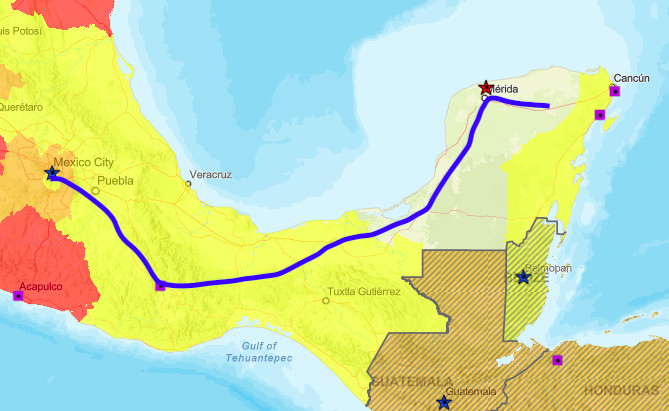 U.S. State Department travel advisory to Mexico, May 2024, with our trip in blue
U.S. State Department travel advisory to Mexico, May 2024, with our trip in blue
3.1. What Are Some LGBTQ+-Friendly Destinations In Mexico?
Mexico offers several LGBTQ+-friendly destinations that provide welcoming and inclusive environments for travelers. These cities are known for their vibrant LGBTQ+ scenes, supportive communities, and diverse cultural attractions.
- Mexico City: As the capital, Mexico City is a hub of LGBTQ+ culture with numerous gay bars, clubs, and cultural events. Neighborhoods like Zona Rosa are particularly known for their inclusive atmosphere.
- Puerto Vallarta: This coastal city is renowned as one of the most LGBTQ+-friendly destinations in Mexico. It features beautiful beaches, gay-friendly resorts, and a thriving nightlife scene.
- Guadalajara: The second-largest city in Mexico offers a mix of traditional culture and a growing LGBTQ+ community. It hosts the Guadalajara International Film Festival, which includes a significant LGBTQ+ cinema section.
- San Miguel de Allende: Known for its colonial architecture and thriving arts scene, San Miguel de Allende is increasingly popular among LGBTQ+ travelers seeking a relaxed and culturally rich experience.
- Tulum: This beach town combines Mayan ruins with a bohemian vibe. While it may not have a large gay scene, many resorts and businesses are welcoming and inclusive.
- Oaxaca: Famous for its indigenous culture and colorful arts and crafts, Oaxaca offers a unique and culturally immersive experience. While not explicitly known as an LGBTQ+ hub, its open-minded atmosphere makes it a pleasant destination for LGBTQ+ visitors.
These destinations provide a range of experiences, from vibrant nightlife and cultural events to tranquil retreats and historical explorations, ensuring that LGBTQ+ travelers can find a place that suits their preferences.
4. What Transportation Options Are Available For Traveling Between Cities In Mexico?
Mexico offers various transportation options for traveling between cities, catering to different budgets, time constraints, and preferences. From long-distance buses to domestic flights, here’s a comprehensive overview:
4.1. Long-Distance Buses
- ADO (Autobuses de Oriente): ADO is one of the most reliable and popular bus companies in Mexico. They offer comfortable, safe, and punctual services to numerous destinations. The ADO app makes it easy to check schedules, book tickets, and manage your travel plans. Different classes of buses are available, with more expensive options offering fully reclinable seats and individual screens.
- Other Bus Companies: Besides ADO, other reputable bus companies include Primera Plus, ETN, and Grupo Senda. These also offer comfortable and reliable services, although their routes may vary.
4.2. Domestic Flights
- Airlines: Several airlines operate domestic flights in Mexico, including Aeroméxico, Volaris, VivaAerobus, and Interjet. Flying can save significant travel time, especially for longer distances.
- Booking: Book flights in advance to secure better prices. Consider flying into major hubs like Mexico City or Cancún and then connecting to smaller cities.
4.3. Tren Maya (Mayan Train)
- Currently in Development: As of May 2024, the Tren Maya is still under development, but once operational, it will offer a comfortable and efficient way to travel through the Yucatán Peninsula. This train route will connect major tourist destinations and archeological sites, providing an alternative to buses and flights.
4.4. Rental Cars
- Availability: Rental cars are available in most major cities and airports. However, driving in Mexico can be challenging due to traffic, road conditions, and safety concerns.
- Considerations: If you choose to rent a car, ensure you have adequate insurance and familiarize yourself with local traffic laws. It’s also wise to avoid driving at night in certain areas.
4.5. Local Transportation
- Taxis and Ride-Sharing: Within cities, taxis and ride-sharing services like Uber are readily available. Confirm the fare before starting your journey with taxis, and use reputable apps for ride-sharing.
- Local Buses and Colectivos: In smaller towns and for short distances, local buses and colectivos (shared vans) are an affordable option. However, they can be crowded and less comfortable.
4.6. Tips for Transportation in Mexico
- Book in Advance: For buses and flights, booking in advance is recommended, especially during peak travel seasons.
- Use Apps: Utilize apps like Google Translate for Spanish translations and the ADO bus app for schedules and bookings.
- Stay Safe: Always be aware of your surroundings and take precautions against theft, especially in crowded areas like bus terminals.
5. What Should I Pack For A Trip To Mexico?
Packing for a trip to Mexico depends on the destinations you plan to visit and the activities you’ll be engaging in. Here’s a comprehensive packing list tailored for a diverse Mexican adventure:
-
Clothing:
- Lightweight and Breathable Fabrics: Pack clothing made from cotton, linen, or moisture-wicking materials to stay comfortable in warm and humid climates.
- Versatile Outfits: Choose items that can be mixed and matched for various occasions.
- Swimwear: If you plan to visit coastal areas or cenotes, bring at least two swimsuits.
- Cover-Ups: Pack a sarong or light cover-up for beach days and modest attire when visiting religious sites.
- Comfortable Walking Shoes: Essential for exploring cities, archeological sites, and natural landscapes.
- Sandals or Flip-Flops: Suitable for beach destinations and casual outings.
- Light Jacket or Sweater: Evenings in some areas, especially at higher altitudes like Mexico City and San Cristobal de las Casas, can be cool.
- Rain Gear: Depending on the season and region, a lightweight raincoat or umbrella may be necessary.
- Formal Attire: If you plan to attend special events or dine at upscale restaurants, pack a few dressier items.
-
Accessories:
- Sunscreen: High SPF, broad-spectrum sunscreen is crucial for protecting your skin from the strong Mexican sun.
- Sunglasses: Essential for shielding your eyes from the sun.
- Hat: Wide-brimmed hats provide additional sun protection.
- Insect Repellent: Especially important if you plan to visit tropical areas or during the rainy season.
- Reusable Water Bottle: Stay hydrated and reduce plastic waste.
- Travel Adapter: If your electronics use a different voltage, bring a universal travel adapter.
- Daypack: A lightweight backpack for carrying essentials during day trips.
- Money Belt or Anti-Theft Bag: For securing valuables in crowded areas.
-
Personal Care Items:
- Toiletries: Travel-sized toiletries to save space and weight.
- Medications: Any prescription medications you require, along with a copy of your prescription.
- First-Aid Kit: Basic supplies like band-aids, antiseptic wipes, pain relievers, and diarrhea medication.
- Hand Sanitizer: Useful for maintaining hygiene on the go.
-
Electronics:
- Smartphone: For navigation, communication, and accessing travel apps.
- Camera: To capture your travel memories.
- Portable Charger: To keep your devices powered throughout the day.
- Headphones: For entertainment during long bus or plane rides.
-
Documents:
- Passport: Ensure your passport is valid for at least six months beyond your travel dates.
- Visa: If required, obtain a Mexican visa before your trip.
- Copies of Important Documents: Keep digital and physical copies of your passport, visa, driver’s license, and travel itinerary in a separate location from the originals.
- Travel Insurance Information: Carry a copy of your travel insurance policy and emergency contact information.
- Flight and Accommodation Confirmations: Print or save digital copies of your flight and hotel bookings.
-
LGBTQ+-Specific Items:
- Information on Local LGBTQ+ Resources: Keep a list of LGBTQ+ organizations, helplines, and community centers in the areas you plan to visit.
- Copies of Legal Documents: If applicable, carry copies of documents related to name or gender changes, especially if they differ from your passport information.
6. What Cultural Experiences Should I Include In My Mexico Itinerary?
Mexico offers a wealth of cultural experiences that should be included in any itinerary. From ancient archeological sites to vibrant festivals, here are some must-see cultural highlights:
6.1. Archeological Sites
- Teotihuacán (near Mexico City): Explore the ancient city of Teotihuacán, known for its impressive pyramids and structures. Visit the Pyramid of the Sun and the Pyramid of the Moon for stunning views.
- Palenque (Chiapas): Discover the Mayan ruins of Palenque, nestled in the rainforest. Admire the intricate carvings and well-preserved architecture.
- Uxmal (Yucatán): Tour the archeological site of Uxmal, featuring detailed Mayan architecture and impressive structures like the Pyramid of the Magician.
- Chichen Itza (Yucatán): Visit Chichen Itza, one of the New Seven Wonders of the World. Explore the iconic pyramid El Castillo and learn about Mayan history.
- Edzna (Campeche): Discover the Mayan site of Edzna, known for its unique architecture and serene atmosphere.
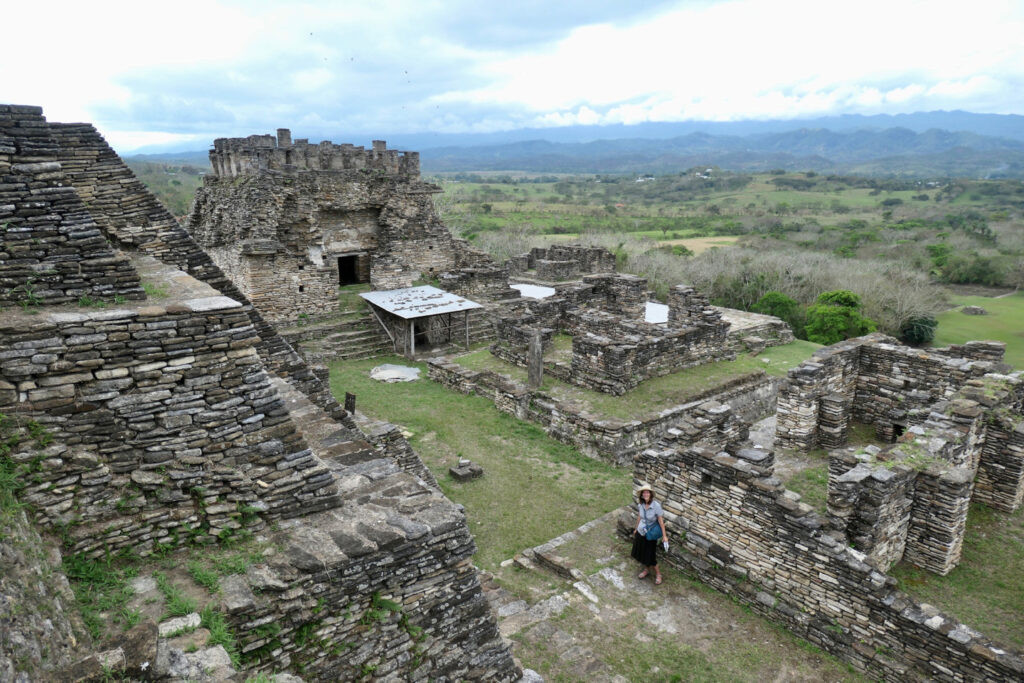 Toniná road trip through Mexico archeological site
Toniná road trip through Mexico archeological site
6.2. Museums and Historical Sites
- National Museum of Anthropology (Mexico City): Immerse yourself in Mexico’s rich history and culture at the National Museum of Anthropology. View extensive collections of artifacts from various pre-Columbian civilizations.
- Frida Kahlo Museum (Mexico City): Visit the Frida Kahlo Museum, also known as Casa Azul (Blue House). Learn about the life and art of the iconic Mexican artist.
- Palacio de Bellas Artes (Mexico City): Admire the stunning architecture and murals at the Palacio de Bellas Artes. Attend a performance to experience Mexican folklore ballet.
- Historic Center of Mexico City: Wander through the Historic Center of Mexico City, a UNESCO World Heritage site. Explore landmarks like the Zócalo, Metropolitan Cathedral, and Templo Mayor.
- Campeche Colonial Mansions: Explore Campeche, a UNESCO World Heritage city. Visit colonial mansions, now museums and hotels.
6.3. Festivals and Events
- Día de los Muertos (Day of the Dead): Experience the vibrant and colorful Día de los Muertos celebrations, typically held from October 31 to November 2. Observe traditional rituals, admire elaborate altars, and enjoy cultural performances.
- Guelaguetza (Oaxaca): Attend the Guelaguetza festival in Oaxaca, a celebration of indigenous cultures. Watch traditional dances, music performances, and craft displays.
- Independence Day (September 16): Celebrate Mexico’s Independence Day with festive parades, fireworks, and cultural events.
- Carnaval (Various Locations): Participate in Carnaval celebrations in cities like Mazatlán and Veracruz. Enjoy parades, music, and dance performances.
- Christmas Posadas: Experience traditional Christmas Posadas, reenactments of Mary and Joseph’s search for lodging.
6.4. Local Markets and Cuisine
- Mercado Medellín (Mexico City): Explore Mercado Medellín, a diverse market offering international foods and Mexican specialties.
- Oaxaca Markets: Visit local markets in Oaxaca, such as Mercado Benito Juárez and Mercado 20 de Noviembre. Sample regional delicacies like mole, tlayudas, and mezcal.
- Street Food Tours: Take a street food tour to sample authentic Mexican cuisine. Try tacos, tamales, elotes, and churros.
- Cooking Classes: Participate in a cooking class to learn how to prepare traditional Mexican dishes.
6.5. Natural Wonders
- Cenotes (Yucatán Peninsula): Swim in the crystal-clear waters of cenotes, natural sinkholes that are unique to the Yucatán Peninsula.
- Agua Azul Waterfalls (Chiapas): Visit the stunning Agua Azul waterfalls, known for their turquoise waters and cascading pools.
- Misol-Ha Waterfall (Chiapas): Discover the Misol-Ha waterfall, where you can walk behind the cascading water.
7. What Are Some Tips For LGBTQ+ Travelers To Ensure A Safe And Enjoyable Trip?
To ensure a safe and enjoyable trip to Mexico, LGBTQ+ travelers should consider the following tips:
- Research Destinations: Prioritize travel to LGBTQ+-friendly destinations such as Mexico City, Puerto Vallarta, and Guadalajara, where there is greater acceptance and established LGBTQ+ communities.
- Stay Informed: Before traveling, check travel advisories and local news for any safety concerns or specific issues affecting LGBTQ+ individuals.
- Accommodation Choices: Opt for accommodations that are known to be LGBTQ+-friendly. Many hotels and guesthouses openly welcome LGBTQ+ guests and offer inclusive services.
- Transportation Safety: Use reputable transportation services, especially at night. Stick to well-lit and populated areas when walking.
- Local Laws and Customs: Understand local laws and customs regarding LGBTQ+ rights. While Mexico has made progress in LGBTQ+ rights, societal attitudes can vary significantly by region.
- Be Discreet When Necessary: In more conservative areas, avoid public displays of affection that might draw unwanted attention.
- Connect with Local Communities: Reach out to local LGBTQ+ organizations or community centers for information and support. Connecting with local communities can provide valuable insights and a sense of security.
- Share Your Itinerary: Keep friends or family informed about your travel plans, including your itinerary and contact information.
- Emergency Contacts: Have a list of emergency contacts readily available, including local LGBTQ+ support organizations, embassies, and consulates.
- Respect Local Culture: Be respectful of local customs and traditions. While some areas are very accepting, others may have more conservative views.
- Travel Insurance: Ensure your travel insurance covers any potential medical needs or emergencies.
8. How Can I Learn Basic Spanish To Enhance My Travel Experience?
Learning basic Spanish can significantly enhance your travel experience in Mexico, making interactions with locals easier and more enriching. Here are some effective ways to learn essential Spanish:
-
Language Learning Apps:
- Duolingo: This app offers gamified lessons that cover essential vocabulary and grammar. It’s great for beginners and helps you build a basic understanding of the language.
- Memrise: Focuses on vocabulary acquisition through flashcards and mnemonic techniques. It also includes videos of native speakers, which can help with pronunciation.
- Babbel: Provides structured courses designed by language experts, covering grammar, vocabulary, and practical conversational skills.
-
Online Courses:
- Coursera and edX: These platforms offer courses from universities around the world, including introductory Spanish courses.
- italki: Connect with native Spanish speakers for one-on-one lessons. This is a great way to practice speaking and get personalized feedback.
- SpanishDict: Offers comprehensive grammar explanations, vocabulary lists, and interactive quizzes.
-
Language Exchange Partners:
- HelloTalk: This app connects you with native Spanish speakers who are learning your native language. You can exchange language skills through text, voice, and video chats.
- Tandem: Similar to HelloTalk, Tandem helps you find language exchange partners and practice speaking in real-time.
-
Phrasebooks and Travel Guides:
- Lonely Planet Spanish Phrasebook: A handy resource with essential phrases for travel situations, including ordering food, asking for directions, and making small talk.
- Rick Steves Spanish Phrase Book & Dictionary: Offers practical phrases and cultural insights to help you navigate your trip.
-
Immersive Learning:
- Take a Spanish Class in Mexico: Consider enrolling in a Spanish class at your destination. Cities like Mexico City, Oaxaca, and San Cristobal de las Casas offer affordable language programs.
- Watch Spanish-Language Media: Watch Spanish-language movies, TV shows, and YouTube channels. Start with subtitles and gradually reduce your reliance on them.
- Listen to Spanish Music and Podcasts: Immerse yourself in the language by listening to Spanish music and podcasts. This can help you improve your listening comprehension and vocabulary.
8.1. Essential Spanish Phrases For Travelers
Knowing a few essential Spanish phrases can significantly enhance your travel experience in Mexico. Here are some helpful phrases to learn:
-
Greetings and Basic Expressions:
- Hola (Hello)
- Buenos días (Good morning)
- Buenas tardes (Good afternoon)
- Buenas noches (Good evening/night)
- ¿Cómo está? (How are you? – formal)
- ¿Cómo estás? (How are you? – informal)
- Bien, gracias (Fine, thank you)
- Por favor (Please)
- Gracias (Thank you)
- De nada (You’re welcome)
- Con permiso (Excuse me)
- Lo siento (I’m sorry)
- Sí (Yes)
- No (No)
-
Basic Questions:
- ¿Cómo se llama? (What is your name?)
- ¿De dónde es? (Where are you from?)
- ¿Habla inglés? (Do you speak English?)
- No entiendo (I don’t understand)
- ¿Cuánto cuesta? (How much does it cost?)
- ¿Dónde está…? (Where is…?)
- ¿A qué hora…? (At what time…?)
- ¿Por qué? (Why?)
- ¿Quién? (Who?)
- ¿Qué? (What?)
-
Directions:
- A la derecha (To the right)
- A la izquierda (To the left)
- Derecho (Straight ahead)
- Cerca (Near)
- Lejos (Far)
- ¿Cómo llego a…? (How do I get to…?)
-
Food and Dining:
- ¿Tiene una mesa para…? (Do you have a table for…?)
- La carta, por favor (The menu, please)
- ¿Qué me recomienda? (What do you recommend?)
- Soy vegetariano/a (I am a vegetarian)
- Sin carne, por favor (Without meat, please)
- La cuenta, por favor (The bill, please)
- Salud (Cheers)
- Delicioso (Delicious)
-
Accommodation:
- Tengo una reserva (I have a reservation)
- ¿Tiene habitaciones disponibles? (Do you have any rooms available?)
- ¿Cuánto cuesta por noche? (How much does it cost per night?)
- ¿Hay wifi? (Is there wifi?)
-
Emergencies:
- ¡Ayuda (Help)
- ¡Socorro (Help)
- Necesito un médico (I need a doctor)
- Llame a la policía (Call the police)
- Estoy perdido/a (I am lost)
9. What Budget Should I Plan For A Trip To Mexico, And How Can I Save Money?
Planning a budget for a trip to Mexico depends on your travel style, destinations, and preferences. Mexico offers options for various budgets, from backpacking to luxury travel. Here’s a detailed guide to help you plan and save money:
9.1. Average Daily Costs
-
Budget Traveler (Backpacker): $30 – $50 USD per day
- Accommodation: Hostels or budget guesthouses ($10 – $20 per night)
- Food: Street food, local markets, and inexpensive eateries ($10 – $15 per day)
- Transportation: Local buses and colectivos ($5 – $10 per day)
- Activities: Free walking tours and low-cost attractions ($5 – $10 per day)
-
Mid-Range Traveler: $75 – $150 USD per day
- Accommodation: Comfortable hotels or Airbnb rentals ($30 – $75 per night)
- Food: A mix of local restaurants and some tourist-oriented establishments ($25 – $50 per day)
- Transportation: ADO buses, taxis, and occasional domestic flights ($10 – $25 per day)
- Activities: Guided tours, entrance fees to major attractions ($10 – $30 per day)
-
Luxury Traveler: $200+ USD per day
- Accommodation: High-end hotels and resorts ($100+ per night)
- Food: Fine dining experiences and upscale restaurants ($75+ per day)
- Transportation: Private transfers and domestic flights ($25+ per day)
- Activities: Exclusive tours, private guides, and premium experiences ($50+ per day)
9.2. Tips for Saving Money
- Travel During the Off-Season: The shoulder seasons (late April to May and September to early November) offer lower prices and fewer crowds.
- Opt for Local Transportation: Use local buses and colectivos instead of taxis or rental cars whenever possible.
- Eat at Local Markets and Street Food Stalls: Enjoy delicious and affordable meals at local markets and street food stalls.
- Book Accommodation in Advance: Look for deals and discounts by booking your accommodation in advance, especially during peak seasons.
- Consider Hostels and Guesthouses: Hostels and guesthouses offer budget-friendly accommodation options, often with social atmospheres.
- Take Advantage of Free Activities: Many cities offer free walking tours and have parks, plazas, and public art to explore.
- Cook Your Own Meals: If your accommodation has kitchen facilities, cook some of your meals to save money on dining out.
- Bargain Respectfully: In markets and smaller shops, it’s often possible to bargain respectfully for a better price.
- Use Public Transportation from the Airport: Instead of taking a taxi, use public transportation like buses or the metro to get from the airport to your accommodation.
- Avoid Tourist Traps: Be wary of tourist traps, such as overpriced restaurants and souvenir shops. Look for more authentic and affordable options.
- Pack Light: Avoid checked baggage fees by packing light and using a carry-on suitcase.
9.3. Example Budget Breakdown (10-Day Trip)
Here’s an example budget breakdown for a 10-day trip to Mexico, based on different travel styles:
-
Budget Traveler:
- Accommodation: $15 per night x 10 nights = $150
- Food: $15 per day x 10 days = $150
- Transportation: $7.5 per day x 10 days = $75
- Activities: $7.5 per day x 10 days = $75
- Total: $450
-
Mid-Range Traveler:
- Accommodation: $50 per night x 10 nights = $500
- Food: $40 per day x 10 days = $400
- Transportation: $17.5 per day x 10 days = $175
- Activities: $20 per day x 10 days = $200
- Total: $1275
-
Luxury Traveler:
- Accommodation: $150 per night x 10 nights = $1500
- Food: $100 per day x 10 days = $1000
- Transportation: $50 per day x 10 days = $500
- Activities: $100 per day x 10 days = $1000
- Total: $4000
10. What Are Some Recommended Itineraries For Exploring Mexico?
Mexico offers diverse itineraries catering to various interests, from cultural explorations to beach getaways. Here are some recommended itineraries for exploring Mexico:
10.1. One Week Cultural Immersion (Mexico City & Oaxaca)
This itinerary focuses on exploring the rich cultural heritage of Mexico, ideal for first-time visitors.
-
Day 1-3: Mexico City
- Accommodation: Stay in Roma or La Condesa for a safe and vibrant experience.
- Activities: Visit the National Museum of Anthropology, explore the Historic Center, and take a food tour.
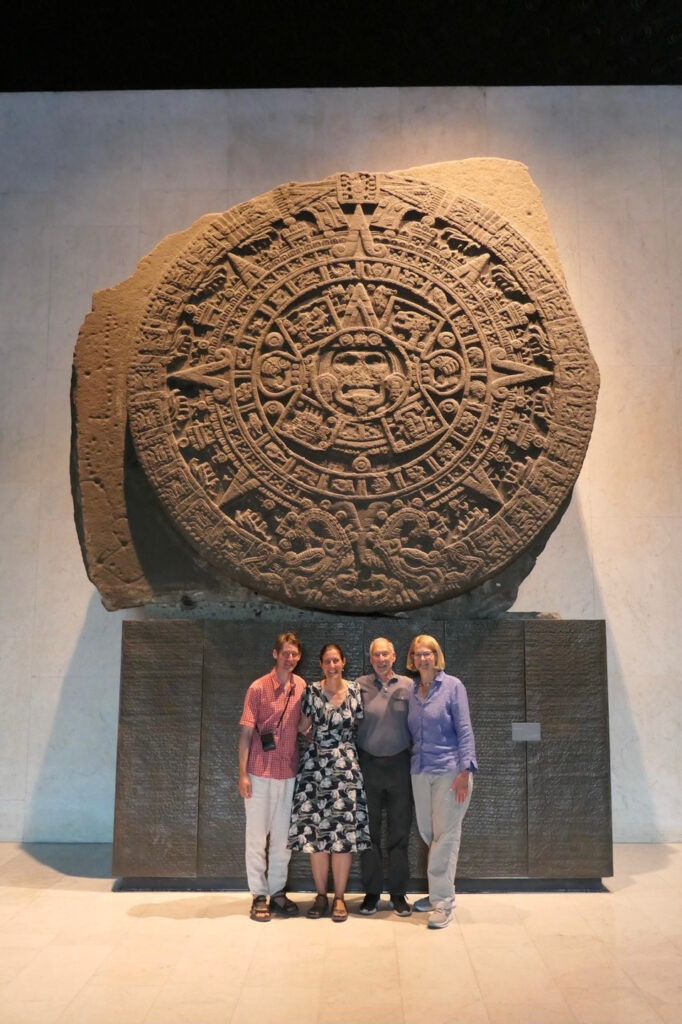 Archeological museum Mexico City
Archeological museum Mexico City
-
Day 4: Travel to Oaxaca
- Transportation: Take an overnight ADO bus to Oaxaca.
-
Day 5-7: Oaxaca
- Accommodation: Stay in the city center for easy access to attractions.
- Activities: Explore local markets, visit Monte Albán, and enjoy the vibrant street art.
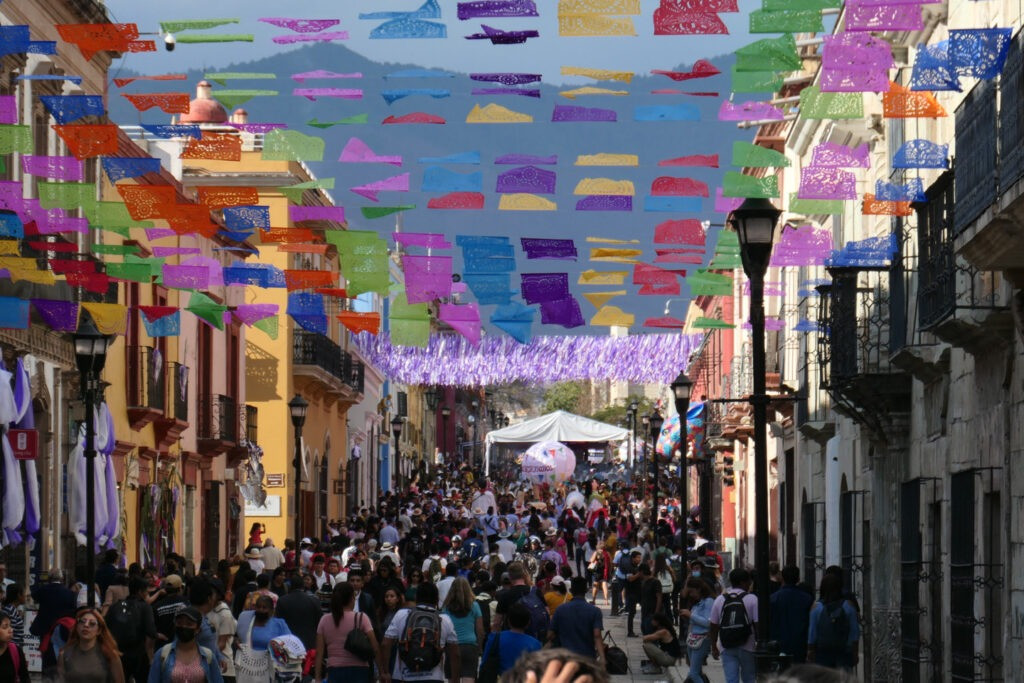 Oaxaca street scene
Oaxaca street scene
10.2. Two Week Yucatán Peninsula Adventure
This itinerary explores the Mayan history and natural beauty of the Yucatán Peninsula.
-
Day 1-3: Mérida
- Accommodation: Stay in Mérida’s historic center.
- Activities: Explore Mérida’s cultural performances, visit the Mayan museum, and explore Uxmal.
-
Day 4-5: Chichen Itza & Cenotes
- Activities: Visit Chichen Itza, one of the New Seven Wonders of the World.
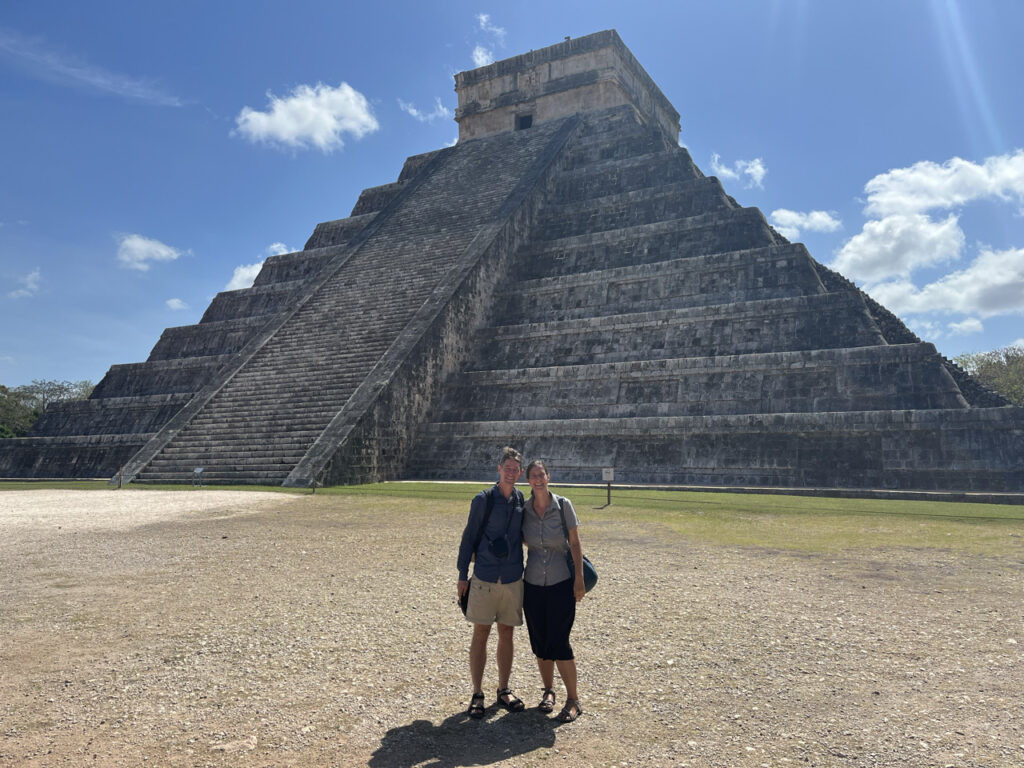 Chichen Itza
Chichen Itza
-
Day 6-7: Campeche
- Accommodation: Stay in a colonial-style hotel or Airbnb.
- Activities: Explore the city walls, visit colonial mansions, and museums, and take a day trip to Edzna.
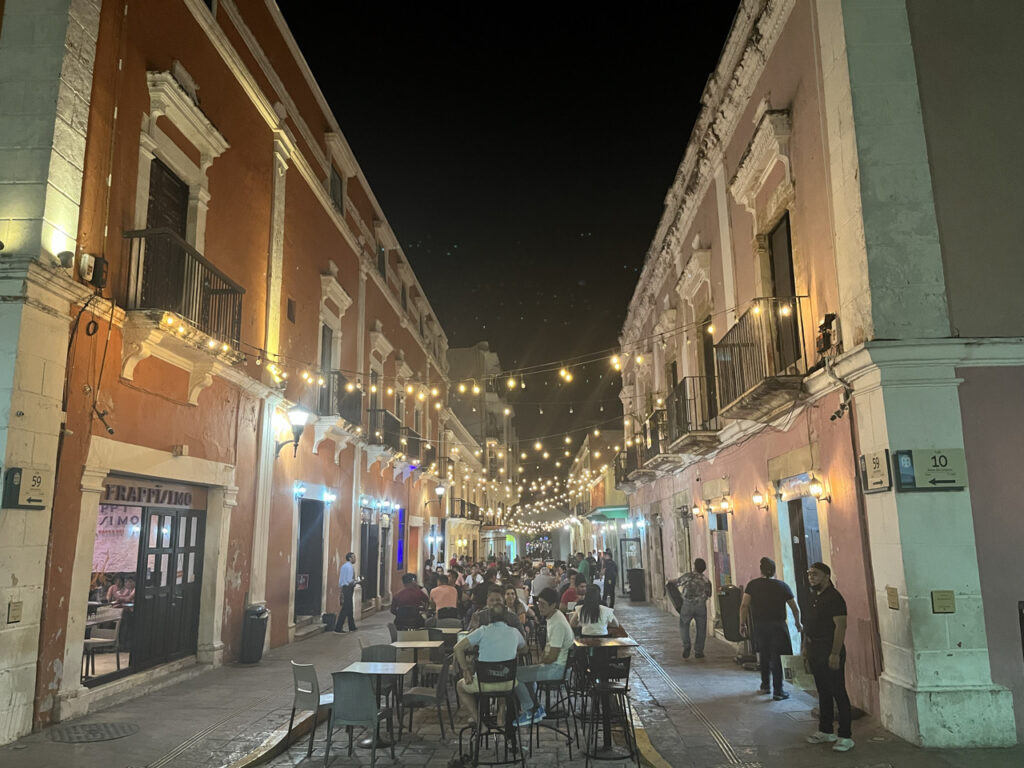 Campeche night scene
Campeche night scene
-
Day 8-10: Tulum & Playa del Carmen
- Accommodation: Stay in Tulum for a bohemian vibe or Playa del Carmen for vibrant nightlife.
- Activities: Visit the Tulum ruins, relax on the beaches, and explore nearby cenotes.
-
Day 11-14: Cancún
- Accommodation: Enjoy beach resort life in Cancún.
- Activities: Relax on the beaches or enjoy water activities.
10.3. Three Week Extended Mexico Exploration
This itinerary combines cultural experiences with natural wonders, perfect for a longer trip.
-
Week 1: Mexico City & Oaxaca
- Follow the one-week cultural immersion itinerary.
-
Week 2: Chiapas (San Cristobal & Palenque)
- Accommodation: Stay in San Cristobal de las Casas for a quiet refuge and visit Palenque.
- Activities: Take a free walking tour in San Cristobal, visit Toniná, Agua Azul, and Misol-Ha on the way to Palenque.
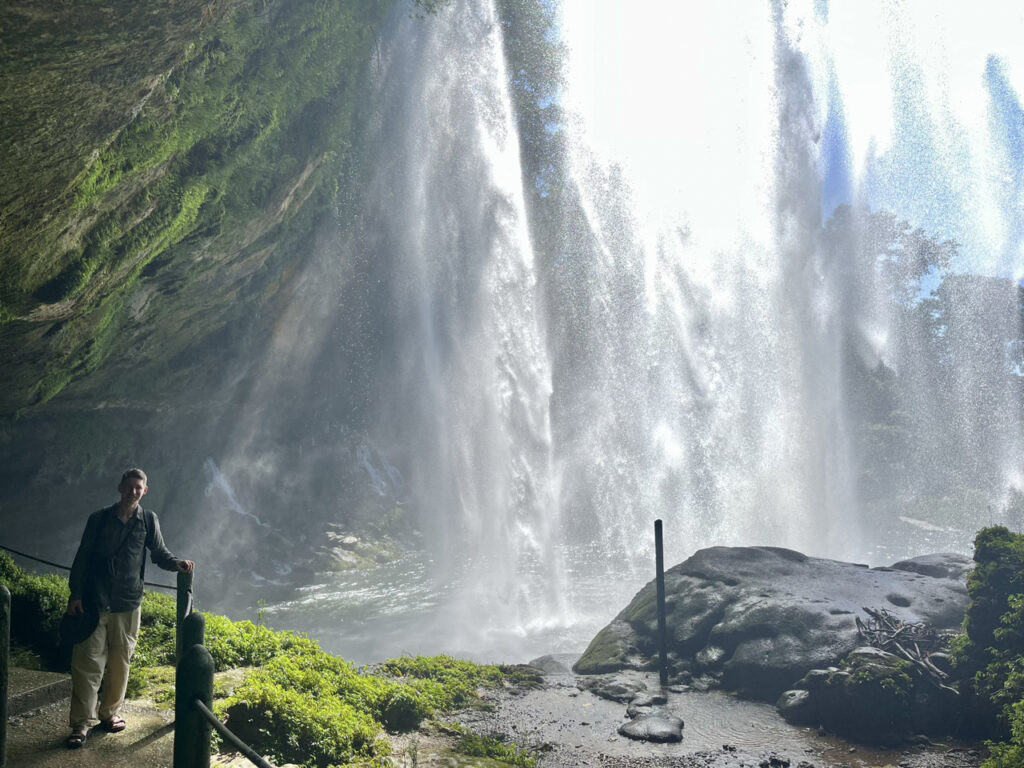 Misol-Ha waterfall
Misol-Ha waterfall
-
Week 3: Yucatán Peninsula (Mérida, Campeche, Tulum & Cancún)
- Follow the two-week Yucatán Peninsula adventure itinerary.
FAQ: Planning Your Mexico Trip
1. Is Mexico safe for LGBTQ+ tourists?
While Mexico has made legal strides in LGBTQ+ rights, societal acceptance varies. Major cities like Mexico City and Puerto Vallarta are very LGBTQ+-friendly, but it’s wise to be more discreet in smaller towns.
2. What are the must-visit cities in Mexico for LGBTQ+ travelers?
Mexico City and Puerto Vallarta are the top choices. Guadalajara also has a growing LGBTQ+ scene.